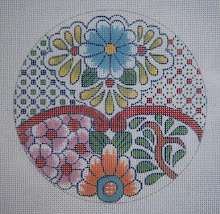 When I was in college, I had a year of rather intense study of textiles, in preparation for the degree in interior design. At that time - 150 years ago, the only synthetics we had were nylon, orlon, and rayon. (rayon is actually a vegetable fiber composite), so the emphasis was on fiber content and weaving techniques, with a bit of dye methods and chemicals thrown in.
When I was in college, I had a year of rather intense study of textiles, in preparation for the degree in interior design. At that time - 150 years ago, the only synthetics we had were nylon, orlon, and rayon. (rayon is actually a vegetable fiber composite), so the emphasis was on fiber content and weaving techniques, with a bit of dye methods and chemicals thrown in. This sort of thing really opens the eyes and gives one an appreciation of fabrics - and recognition when we see them. Very early in my needlepoint design activities, I decided that to alleviate the visual boredom of a plain background, I could dress it up a bit with woven fabric replicas, and dotted swiss was my first. (My mother loved it, so I wore a lot of it in my early childhood - mostly white.)
Dotted swiss was first made in the mid 18th century in Switzerland, where it was a beautiful, lightweight woven white cotton batiste with small dots woven in. Of course now it is also woven with synthetics, and the dots may be larger and applied - and lots of different colors are used. The dots, however, remain white.
I'm showing my needlepoint version in color in order to show the effect of the raised dots. I use this pattern on things like stocking cuffs and patchwork patterns to give a bit of visual interest. To begin, simply mark dots with your drawing pen on the WARP threads as you see them on the stitched model, and also on the chart. 

When working in white, just basketweave the whole thing, but as you come to a "dot" you will make a cross, so that it appears as a raised bump. When using a colored background, leave the dots bare, and then make X's over them with white thread. The chart with the arrow is showing basketweave with the cross stitch creating the raised bump of the dotted swiss. The dots, of course, can be more widely spaced for a different effect. 

While I was doing this, I couldn't resist going ahead and including one of my favorite effects - "bump" polka dots. These are just marked with little squares instead of a single dot - and worked with Smyrna cross. They could also be stitched in a variety of different colors and placed randomly for a "confetti" effect.
You can see by studying the scan of the marked canvas, that the squares are placed with two stitches between the dots on the diagonal - I have found this to be the easiest and least confusing way to do it - kind of automatic without having to count.
These very simple textured patterns are useful for things like plain background on ornaments - like a sprig of holly on a background that has no other pattern. Also, a little frame around a name or monogram works well. Lots of uses if you think about it!!



Great instructions, as always, Judy! I've scheduled a link to this post to go live on my blog in a little while. I hope it brings you a few extra clicks.
ReplyDeleteDenise
http://needlework.craftgossip.com